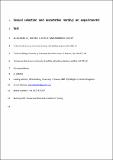Files in this item
Sexual selection and assortative mating : an experimental test
Item metadata
| dc.contributor.author | Debelle, A. | |
| dc.contributor.author | Ritchie, Michael Gordon | |
| dc.contributor.author | Snook, R. R. | |
| dc.date.accessioned | 2017-03-26T00:32:57Z | |
| dc.date.available | 2017-03-26T00:32:57Z | |
| dc.date.issued | 2016-07-11 | |
| dc.identifier | 241587264 | |
| dc.identifier | 3bd67702-a193-4e84-9d31-d7aa040707df | |
| dc.identifier | 000382500100003 | |
| dc.identifier | 85028256475 | |
| dc.identifier.citation | Debelle , A , Ritchie , M G & Snook , R R 2016 , ' Sexual selection and assortative mating : an experimental test ' , Journal of Evolutionary Biology , vol. 29 , no. 7 , pp. 1307-1316 . https://doi.org/10.1111/jeb.12855 | en |
| dc.identifier.issn | 1420-9101 | |
| dc.identifier.other | Bibtex: urn:fab6f287e8438ce021a6c44cdace83ff | |
| dc.identifier.other | ORCID: /0000-0001-7913-8675/work/46761153 | |
| dc.identifier.uri | https://hdl.handle.net/10023/10525 | |
| dc.description | This work was funded by the Marie Curie Initial Training Network ‘Understanding the evolutionary origin of biological diversity’ (ITN-2008-213780 SPECIATION) and by a US National Science Foundation grant (DEB 0093149) and NERC grants (NE/B504065/1; NE/D003741/1) to RRS. | en |
| dc.description.abstract | Mate choice and mate competition can both influence the evolution of sexual isolation between populations. Assortative mating may arise if traits and preferences diverge in step, and, alternatively, mate competition may counteract mating preferences and decrease assortative mating. Here, we examine potential assortative mating between populations of Drosophila pseudoobscura that have experimentally evolved under either increased (‘polyandry’) or decreased (‘monogamy’) sexual selection intensity for 100 generations. These populations have evolved differences in numerous traits, including a male signal and female preference traits. We use a two males: one female design, allowing both mate choice and competition to influence mating outcomes, to test for assortative mating between our populations. Mating latency shows subtle effects of male and female interactions, with females from the monogamous populations appearing reluctant to mate with males from the polyandrous populations. However, males from the polyandrous populations have a significantly higher probability of mating regardless of the female's population. Our results suggest that if populations differ in the intensity of sexual selection, effects on mate competition may overcome mate choice. | |
| dc.format.extent | 10 | |
| dc.format.extent | 311152 | |
| dc.language.iso | eng | |
| dc.relation.ispartof | Journal of Evolutionary Biology | en |
| dc.subject | Drosophila | en |
| dc.subject | Experimental evolution | en |
| dc.subject | Female preference | en |
| dc.subject | Mate competition | en |
| dc.subject | Sexual conflict | en |
| dc.subject | Sexual isolation | en |
| dc.subject | Speciation | en |
| dc.subject | QH301 Biology | en |
| dc.subject | NDAS | en |
| dc.subject.lcc | QH301 | en |
| dc.title | Sexual selection and assortative mating : an experimental test | en |
| dc.type | Journal article | en |
| dc.contributor.sponsor | European Commission | en |
| dc.contributor.sponsor | NERC | en |
| dc.contributor.institution | University of St Andrews. School of Biology | en |
| dc.contributor.institution | University of St Andrews. Centre for Biological Diversity | en |
| dc.contributor.institution | University of St Andrews. Institute of Behavioural and Neural Sciences | en |
| dc.identifier.doi | https://doi.org/10.1111/jeb.12855 | |
| dc.description.status | Peer reviewed | en |
| dc.date.embargoedUntil | 2017-03-25 | |
| dc.identifier.grantnumber | 213780 | en |
| dc.identifier.grantnumber | NE/I014632/1 | en |
This item appears in the following Collection(s)
Items in the St Andrews Research Repository are protected by copyright, with all rights reserved, unless otherwise indicated.

